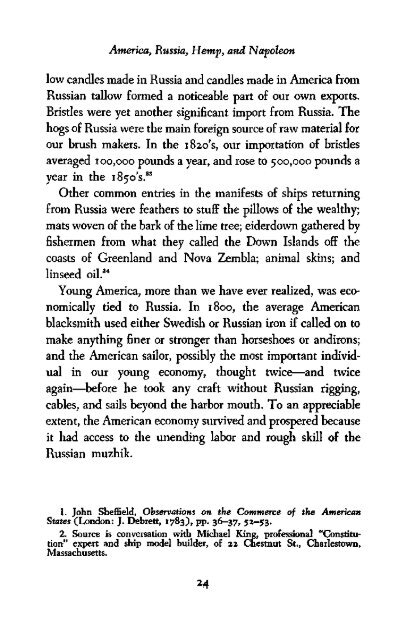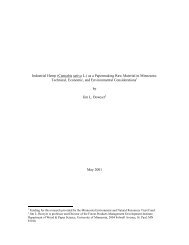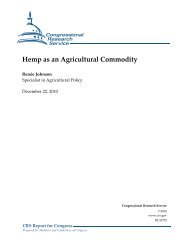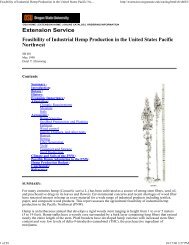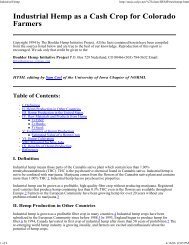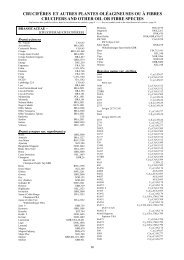- Page 1 and 2: gmertca,, ?|emp, an& JUapoleonAmeri
- Page 5: America, Hossia, fiemp, and Bapolco
- Page 8 and 9: Co'pyright (c) 1965 by the Ohio Sta
- Page 11: ContentsI. The Beginnings 3II. Hemp
- Page 15 and 16: 1Wai BeginningsIY COUNTRYMEN, SIRE,
- Page 17 and 18: The BeginningsRussia. H e encourage
- Page 19 and 20: The Beginningsand unloaded there. I
- Page 21 and 22: The Beginningserine the Great. "The
- Page 23 and 24: The Beginningsdictates,firstdeposit
- Page 25 and 26: The Beginnings12. Price, Tobacco Ad
- Page 27 and 28: Hemp,Flax, and Iron: The Amelrican
- Page 29 and 30: Hemp, Flax, and Iron: The American
- Page 31 and 32: Hemp, Flax, and Iron: The American
- Page 33 and 34: Hemp,Flax, and Iron: The American V
- Page 35: Hemp, Flax, and Iron: The American
- Page 39 and 40: 3Htmp, flax, and Iron:The RussianQL
- Page 41 and 42: Hemp, Flax, and Iron: The Russian V
- Page 43 and 44: Hemp,Flax, and Iron: The Russian Vi
- Page 45 and 46: Hemp,Flax, and Iron: The Russian Vi
- Page 47 and 48: Hemp, Flax, and Iron: The Russian V
- Page 49 and 50: Hemf, Flax, and Iron: The Russian V
- Page 51 and 52: Hemp, Flax, and Iron: The Russian V
- Page 53 and 54: A New Flag for the Old Tradethe har
- Page 55 and 56: A New Flag for the Old Tradeof thos
- Page 57 and 58: A New Flag for the Old TradeDana re
- Page 59 and 60: Making and Learning the Rulesthe na
- Page 61 and 62: Making and Learning the Rulespart o
- Page 63 and 64: Making and Learning the RulesRowan
- Page 65 and 66: Making and Learning the RulesMessrs
- Page 67 and 68: Making and Learning the RulesCarryi
- Page 69 and 70: Making and Learning the Rulessachus
- Page 71 and 72: Making and Learning the Rulesonions
- Page 73 and 74: Making and Learning the Rulesthe co
- Page 75 and 76: Making and Learning the Ruleslast a
- Page 77 and 78: Making and Learning the Ruleslong j
- Page 79 and 80: Making and Learning the Rulesuncert
- Page 81 and 82: Making and Learning the Rules18. We
- Page 83 and 84: Secretary of State, 12/24 J uneMaki
- Page 85 and 86: Trade in Time of Warcompletely loos
- Page 87 and 88:
Trade in Time of Warhealthy 92 per
- Page 89 and 90:
Trade in Time of Warvived our morib
- Page 91 and 92:
Trade in Time of WarStates was beco
- Page 93 and 94:
Trade in Time of Warwanting the Uni
- Page 95 and 96:
Trade in Time of Waryear of the une
- Page 97 and 98:
Trade in Time of Warfinal "peace" u
- Page 99 and 100:
Trade in Time of WarBefore he slept
- Page 101 and 102:
Trade in Time of War16. Boston Colu
- Page 103 and 104:
7alliances and EmbargoV ! / N 21 M
- Page 105 and 106:
Alliances and EmbargoThe merchant m
- Page 107 and 108:
Alliances and Embargocommerce with
- Page 109 and 110:
Alliances and EmbargoI avail myself
- Page 111 and 112:
Alliances and Embargopower—i.e.,
- Page 113 and 114:
Alliances and EmbargoBy the summer
- Page 115 and 116:
Alliances and Embargo"stood down th
- Page 117 and 118:
Alliances and Embargowar on England
- Page 119 and 120:
Alliances and Embargo16. Samuel Bar
- Page 121 and 122:
fraudulent tradingJ0N 1807, EIGHTY-
- Page 123 and 124:
Fraudulent Tradingon shore. A few o
- Page 125 and 126:
Fraudulent Trading1808 were either
- Page 127 and 128:
Fraudulent Tradingnotorious that w
- Page 129 and 130:
Fraudulent Tradingof France and her
- Page 131 and 132:
Fraudulent Tradingwas Denmark. Denm
- Page 133 and 134:
Fraudulent Tradingbrought into Dani
- Page 135 and 136:
Fraudulent TradingVessels Permitted
- Page 137 and 138:
%\it ©anish problemRESIDENT JEFFER
- Page 139 and 140:
The Danish Problembring such prices
- Page 141 and 142:
The Danish Problemvu avec peine qu'
- Page 143 and 144:
The Danish Problemparticular charge
- Page 145 and 146:
The Danish ProblemIf America's cong
- Page 147 and 148:
The Danish Problemwas over, Sweden
- Page 149 and 150:
The Danish Problemvessels had thus
- Page 151 and 152:
The Danish Problemshuttling neutral
- Page 153 and 154:
The Danish Problemtional protection
- Page 155 and 156:
The Danish ProblemThere they, too,
- Page 157 and 158:
The Danish ProblemIt seems to be a
- Page 159 and 160:
The Danish Problem3. Arthur H . Col
- Page 161 and 162:
The Danish Problem51. Ryan, "The De
- Page 163 and 164:
"A Bull-dog among Spaniels"the stag
- Page 165 and 166:
"A Bull-dog among Spaniels"packet t
- Page 167 and 168:
"A Bull-dog among Spaniels"ing into
- Page 169 and 170:
"A Bull-dog among Spaniels"November
- Page 171 and 172:
"A Bull-dog among Spaniels""Calumet
- Page 173 and 174:
"A Bull-dog among Spaniels"course o
- Page 175 and 176:
"A Bull-dog among Spaniels"thus esc
- Page 177 and 178:
"A Bull-dog among Spaniels"surpasse
- Page 179 and 180:
"A Bull-dog among Spaniels"task in
- Page 181 and 182:
"A Bull-dog among Spaniels"25. Cole
- Page 183 and 184:
Adams in the AscendancyAmerican ves
- Page 185 and 186:
Adams in the Ascendancyindigo, cott
- Page 187 and 188:
Adams in the AscendancyTsar'sfleetf
- Page 189 and 190:
Adams in the AscendancyThe battle w
- Page 191 and 192:
Adams in the Ascendancytreasuries o
- Page 193 and 194:
Adams in the Ascendancygreat convoy
- Page 195 and 196:
Adams in the AscendancyO f 2,000 sh
- Page 197 and 198:
Adams in the Ascendancytheir crews
- Page 199 and 200:
Adams in the Ascendancyprinciple of
- Page 201 and 202:
Adams in the Ascendancyport. Theref
- Page 203 and 204:
Adams in the Ascendancyentered at A
- Page 205 and 206:
Adams in the Ascendancy31. Smith, R
- Page 207 and 208:
12Wnt United States, ©arlingof the
- Page 209 and 210:
The United States, Darling of the B
- Page 211 and 212:
The United States, Darling of the B
- Page 213 and 214:
The United States, Darling of the B
- Page 215 and 216:
The United States, Darling of the B
- Page 217 and 218:
The United States, Darling of the B
- Page 219 and 220:
The United States, Darling of the B
- Page 221 and 222:
The United States, Darling of the B
- Page 223 and 224:
The United States, Darling of the B
- Page 225 and 226:
The United States, Darling of the B
- Page 227 and 228:
The United States, Darling of the B
- Page 229 and 230:
The United States, Darling of the B
- Page 231 and 232:
The United States, Darling of the B
- Page 233 and 234:
The United States, Darling of the B
- Page 235 and 236:
The United States, Darling of the B
- Page 237 and 238:
The United States, Darling of the B
- Page 239 and 240:
The United States, Darling of the B
- Page 241 and 242:
The United States, Darling of the B
- Page 243 and 244:
The Challenge of 18121810 to £731,
- Page 245 and 246:
The Challenge of 1812quays of every
- Page 247 and 248:
The Challenge of 1812best to clear
- Page 249 and 250:
The Challenge of 1812In Russia "the
- Page 251 and 252:
The Challenge of 1812ona," "Brother
- Page 253 and 254:
The Challenge of 1812had been paid
- Page 255 and 256:
The Challenge of 1812non-intercours
- Page 257 and 258:
The Challenge of 181224. C . Adams,
- Page 259 and 260:
The Wars of 1812England, he wrote f
- Page 261 and 262:
The Wars of 1812The Americans at Go
- Page 263 and 264:
The Wars of 1812Smith told Summers
- Page 265 and 266:
The Wars of 1812Th e only American
- Page 267 and 268:
The Wars of 1812plaque in every mar
- Page 269 and 270:
The Wars of 1812Madison's rather pr
- Page 271 and 272:
The Wars of 1812"Frederick" and "Ca
- Page 273 and 274:
The Wars of 1812lonely souls left i
- Page 275 and 276:
The Wars of 1812the "Hannibal" arri
- Page 277 and 278:
The Wars of 1812ruin/' i.e., the de
- Page 279 and 280:
The Wars of 1812Another American po
- Page 281 and 282:
The Wars of 1812The third night out
- Page 283 and 284:
The Wars of 1812American conquest a
- Page 285 and 286:
The Wars of 18123. Smith, Reminisce
- Page 287 and 288:
The Wars of 181240. Caulaincourt, W
- Page 289 and 290:
Postscript: Levett HarrisDiedrich R
- Page 291 and 292:
Postscript: Levett Harrishis consta
- Page 293 and 294:
Appendixances of the United States
- Page 295 and 296:
Appendix7-9 July 1807—Treaties of
- Page 297 and 298:
Appendix5 August 1810—Napoleon in
- Page 299 and 300:
BibliograpliuPRIMARYSOURCESA. Manus
- Page 301 and 302:
Bibliographyjournals of the House o
- Page 303 and 304:
BibliographyThe Miscellaneous Docum
- Page 305 and 306:
BibliographyContains a note or two
- Page 307 and 308:
BibliographyE. journalsFOOTE , HENR
- Page 309 and 310:
BibliographyThe pioneer work in the
- Page 311 and 312:
BibliographyCROUZET, FRANgois. L'Ec
- Page 313 and 314:
HOPKINS,BibliographyJAMES F. A Hist
- Page 315 and 316:
BibliographyContains a few pages on
- Page 317 and 318:
BibliographySCOTT, FRANKLIN D . Ber
- Page 319 and 320:
A few facts of interest.Bibliograph
- Page 321:
BibliographyA n indispensable accou
- Page 324 and 325:
IndexBelts, Great and Little, 61, 1
- Page 326 and 327:
IndexGeorge III, 160Germany, 78, 11
- Page 328 and 329:
IndexMoniteur, 181Monroe, James, 27
- Page 330 and 331:
IndexSheffield, Lord, 46Sherburne,
- Page 332:
IndexWarsaw, 269Woronsow; see Voron
- Page 336:
Previously published . . .Change an


